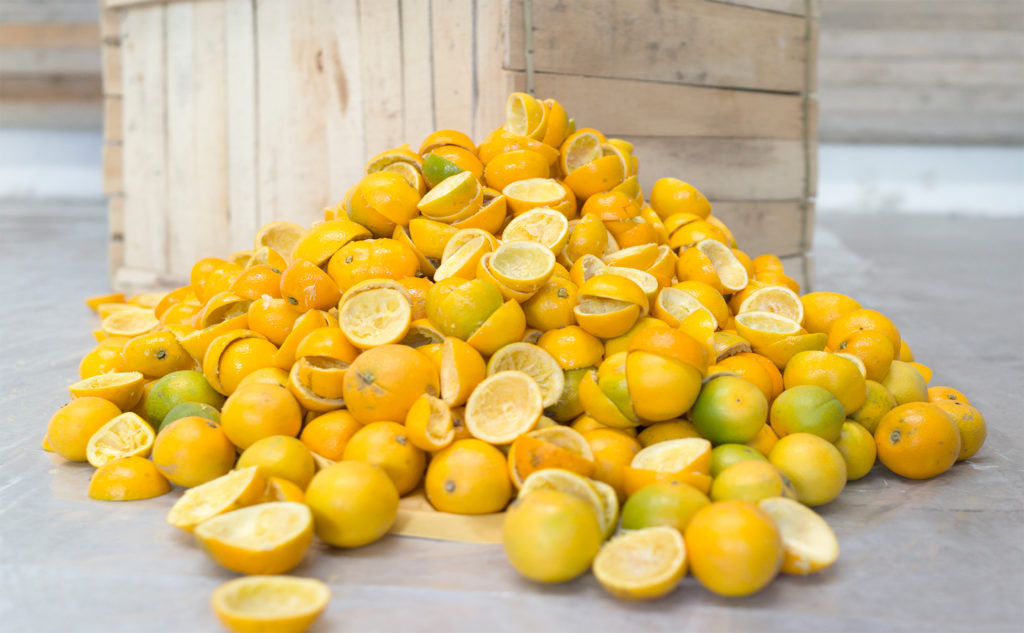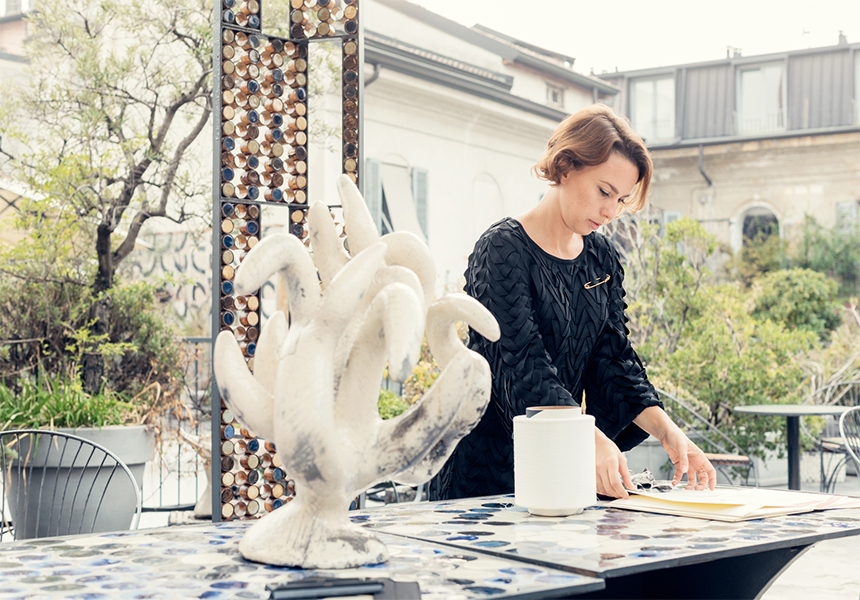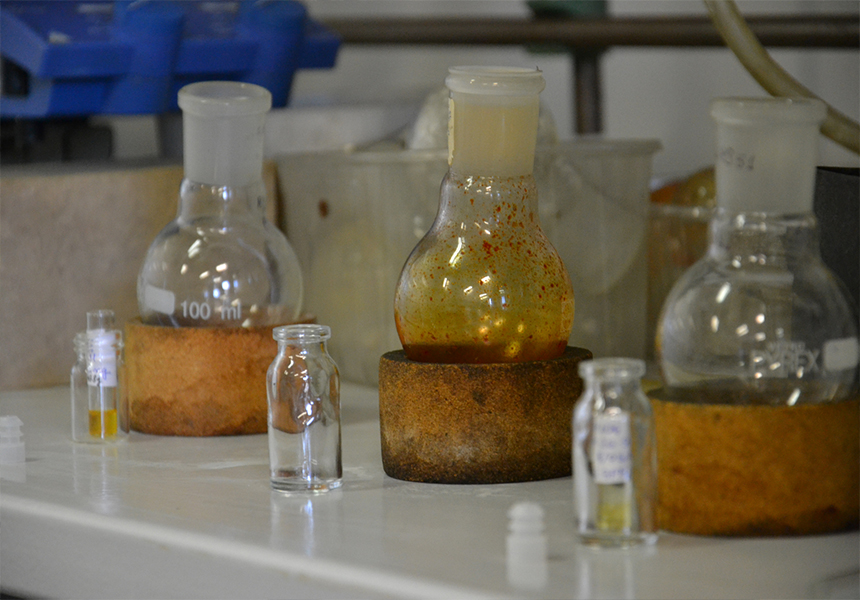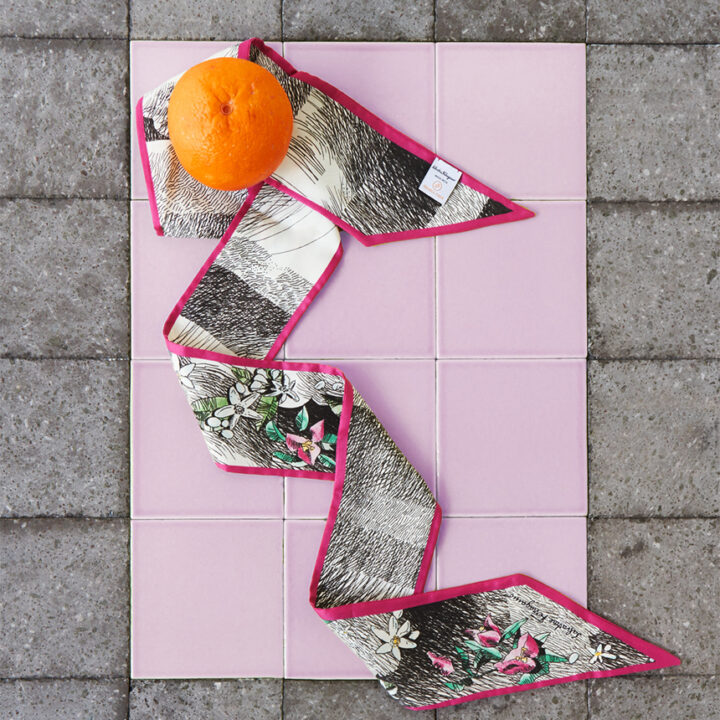Orange Fiber
In 2015, the Italian company Orange Fiber won the Global Change Award, the annual award initiated by H&M Foundation. This spring, their innovation, a luxe fabric made out of citrus juice by-products, is included in one of H&M’s most anticipated collections: Conscious Exclusive. Here, co-founder Enrica Arena shares the story behind the company.
Orange Fiber is made from citrus juice by-products, repurposing them to create silk-like cellulose fabric. Having won H&M Foundation’s Global Change Award in 2015, the founders are now more than ready to scale up production. This year, the fabric is one of many innovative and sustainable materials used in H&M’s annual Conscious Exclusive collection. But how do you come up with the idea of making a luxurious fabric out of waste? We had a chat with Enrica Arena, one of the founders of Orange Fiber.
Can you describe Orange Fiber and its history?
Orange Fiber is an Italian company that has patented and manufactures sustainable fabrics for fashion from citrus juice by-products. Following a collaboration with Politecnico di Milano University, it has been developed with an innovative process that allows turning virtually more than 700,000 tonnes of by-product that the citrus processing industry produces every year in Italy into a high-quality fabric that can respond to the need for sustainability and innovation of fashion brands. The citrus peel would otherwise have to be disposed of, with costs for both the processing industry and the environment. We patented the process in Italy in 2013, and extended to an International Patent Cooperation Treaty the following year.
We presented the first prototypes of fabric from citrus juice by-product in 2014, at the Expo Gate of Milan during Vogue Fashion’s Night Out. The trademark was registered, and the textile market tested by identifying strategic partners in the supply chain that is developing today in Italy and abroad, involving the excellence of the industry. The first pilot plant for the extraction of pulp from citrus was opened in December 2015 in Sicily.
Then, on Earth Day in 2017, the very first fashion collection made with the exclusive Orange Fiber fabric was launched by Salvatore Ferragamo — one of Italy’s top fashion houses and a world leader in the luxury industry. The collaboration represents the shared ethical values underlying the project, shaping the fabric and showcasing its potential for elegant and sustainable applications.
Sustainability and innovation, combined with the Made in Italy sign of quality, distinguish the product and make the company a reference for fashion players that cares about both environmental protection and exclusivity.
What has winning Global Change Award meant to you?
In 2015, Orange Fiber was selected among more than 2,700 projects from 112 different countries and awarded it with a grant of €150,000 and a year of innovation accelerating, provided by the H&M Foundation in collaboration with Accenture and the KTH Royal Institute of Technology in Stockholm. Having the availability of the grant, together with the specialized support received by Accenture and having access to H&M Foundation network with the players in the fashion industry and the manufacturing industry, gave us the chance to achieve great progress in the development of our project, laying a solid foundation for the future of our company.
What was the accelerator year like, how did that impact you?
It was amazing! Through the Innovation Accelerator, we have been supported over the course of a year to help analyse and develop our product while participating in a series of activities and international events. Our first activity was an intense boot camp week in Stockholm at KTH Campus in February. The aim of the boot camp was to outline the stages of the development of our innovation from the initial stage through to the final goal. During this period, all the Global Change Award winners and the technological readiness of our idea was challenged by KTH Innovation through practical workshops which taught us how to pitch our product, IPR protection and innovation development. This was followed by a study week in Shanghai in April, that offered us exclusive industry insight, opportunities to network and deep knowledge of circularity and fashion’s value chain. During this period, we were then coached via virtual and classroom training sessions led by experts from Accenture Strategy to help us tweak and fine-tune our business models. We have learnt a huge amount about the impact of sustainable processes throughout the value chain and we have had the unique chance to further connect the dots in the fashion industry and start building a network with key people within fashion production, sales, materials, innovation and sustainability.
What has been your focus since winning the award?
Since then, our focus has been to grow up, as a company and as professionals — improving our project and increasing our commitment to a greener fashion industry. On a practical level, we understood what was needed for the company to grow out of the “startup zone”, and what the international fashion industry look like. We focused on improving the production process, how to make it scalable and increase our impact and also how to make our product appealing for brands. Last but not least, we are looking for investor and partners at a global scale to make our dream of a greener fashion industry a reality as soon as possible.
Can you describe some positive breakthrough moments since winning GCA?
Thanks to the Global Change Award we significantly moved forward with our R&D, implementing our team and deploying our first-ever pilot production of more than 10,000 meters of fabric. This was pre-booked by the famous fashion brand Salvatore Ferragamo who has used it to create the first-ever collection of clothes made out of citrus, the Ferragamo Orange Fiber Collection. After the launch, during the Green Carpet Fashion Awards Italia in 2017, the Florentine fashion house created an exclusive evening dress, a handbag model from the Museo Salvatore Ferragamo collection and a pair of “F” wedge sandals in Orange Fiber fabrics, worn by top model Karolina Kurkova. And during the Global Change Award ceremony in 2018, the Taiwanese actress, model and sustainability influencer Chiling Lin wore a custom-made Orange Fiber gown by H&M. Actually, an exclusive Salvatore Ferragamo ensemble crafted with our sustainable fabrics from citrus juice by-products is among the 300 fascinating and unsettling objects showcased at the V&A Museum of London for the Fashioned from Nature exhibition, the first UK exhibition to explore the complex relationship between fashion and nature from 1600 to the present day.
What’s the biggest challenge for Orange Fiber?
Our biggest challenges concern the industrial scale up and the optimisation of the costs of production. Practically, on one hand we are working on the process and on the synergies with citrus squeezers and their processes, and on the other hand we are working with industrial players in the cellulosic industry for fabrics to adjust to their standard of productions, while keeping in mind the brand’s requests and preferences that we discovered with our first production and testing our samples on the market with different players.
Also, this process requires time and investment, so we need to attract investors who believe in and support innovation in sustainable fashion.
What’s today’s status of your business?
Today, we are working hard to move forward in the R&D process to a point where we can scale up the technology and restart the production, with a long-term goal of optimising the costs of production. This is crucial to develop new potential collaborations with fashion brands who share our values. Eventually, we want to replicate the technology in Italy and abroad. We have a granted IP in the US, we’re entering the national phases in selected EU countries and it’s pending in India, Brazil and Mexico.
What do you hope for, looking ahead?
For the future, we hope to establish ourselves as the first Italian mover in the segment of sustainable fabrics through a “green” production of cellulosic fabrics from renewable sources, and to create a highly recognisable textile brand for its commitment toward environmental protection and transparency. Further, we want to expand our production outside of Europe in order to increase our impact and minimise our logistics, keeping in mind our sustainability goal.
For more information, head to:
https://globalchangeaward.com/winners/100-percent-citrus/
https://orangefiber.it




